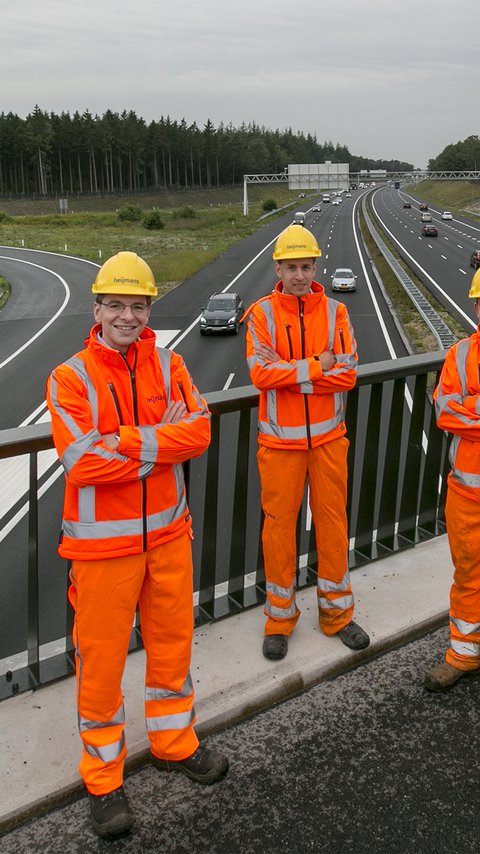
Over the past 18 months, Heijmans has widened the A12 motorway between Ede and Grijsoord from two to three lanes. In July 2016, the motorway was opened to traffic, after which, a 16-year maintenance period kicked in. The Heijmans maintenance team takes its crystal ball and explains how a DBFM project differs from a traditional project.
Heijmans’ Maintenance Manager Erwin van Baal, and Work Planners Samuel van Beek and Martijn van Lieshout have been involved in the A12 Veenendaal – Ede – Grijsoord motorway for a long time. This is particularly noteworthy since the maintenance period has only just started. Martijn: “We were involved as a maintenance team at an early stage, which means that we now are very well aware of what we are responsible for maintaining. We are familiar with the area and we know where the risks lie. Our motto from the very beginning is ‘build together for better maintenance’. We now have to hold on to and continue to develop this thought.”
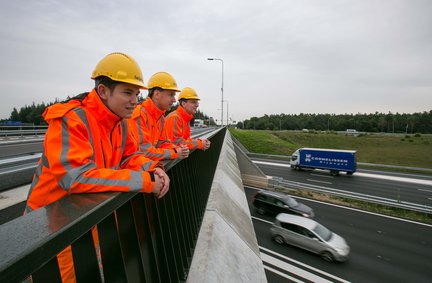
Erwin: “The big difference is that we deliver to our own organization and not to the Directorate-General of Public Works and Water Management (Rijkswaterstaat). We commissioned the road as we conceived it. We were granted an availability certificate for this purpose. In 16 years, after the maintenance period, we will deliver the road to Rijkswaterstaat.”
Strategy
Samuel: “During the tendering phase, we chose a strategy in terms of the material’s design and quality. All of this affects maintenance. Inexpensive at the front-end is expensive at the back-end. Here, we reverse this equation. We are constructing a high-quality, durable road that we can maintain in perfect condition without incurring excessive costs.
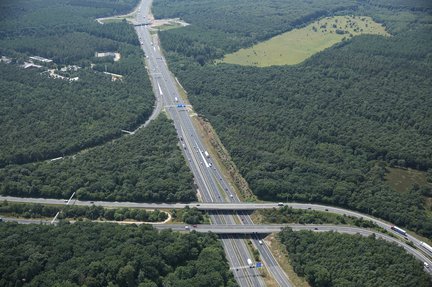
From experience, we know when we need to replace or renovate certain elements. That is nothing new. In recent years, we acquired a great deal of experience with different maintenance contracts. You can subdivide a long-term contract into regular maintenance (standard maintenance activities to maintain the area up to par) and major maintenance. During the upcoming 16 years, there will be a number of instances during which we will be performing major maintenance. Replacing the asphalt is an example. Regular maintenance includes activities such as mowing the shoulders, cleaning culverts and gutters, sweeping the hard shoulders, cleaning the porous asphalt concrete and replacing lamps. These maintenance activities are cyclical in nature. We will be regularly repeating them over the coming 16 years.
We also inspect the road twice a week. Heijmans’ service workers are our eyes and ears on this road. They have to pay attention to everything. And yes, this entails far more that just polishing signs and picking up garbage. In addition to being aware of conditions outside, these workers must also know the contract inside out and be aware of the applicable fines. If they miss the fact that a hole is forming inside the asphalt and we unexpectedly have to go out to fix it, that will cost us € 20,000 every 15 minutes per lane. This is deducted from Rijkswaterstaat’s availability payment. This is something we want to avoid whenever possible.”
Asphalt
A new type of bitumen has been used for the asphalt, which is supposed to last longer as a result. Martijn: “It is a lot more expensive, but it also means that it will last a few more years before we have to replace it.” Erwin: “To put it even more succinctly, during the next 16 years, we will only be replacing the surface layer of the most heavily used R3 lane between Grijsoord and Ede. This is unprecedented.”
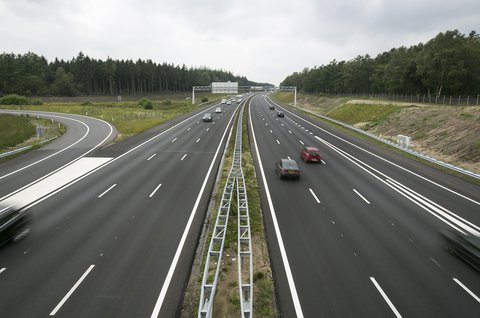
But if you have to replace all of the surface layers in 12 years anyway? Then Heijmans assumes this risk. Samuel: “That is the beauty of a DBFM contract. This leaves Heijmans free to build highly durable structures. The asphalt’s quality has to be perfect and it must be applied under ideal conditions. In fact, the asphalt has to last even longer than 16 years, because of course we cannot just deliver a road full of holes and cracks after 16 years.”
Technical Systems
Erwin: “Our mechanical and electrical systems maintenance team in Veenendaal, managed by Eric Middelhuis, was involved and responsible from the start of construction. Many systems were new and unknown to us. From the very beginning, we invested in training and in collaborating on the implementation. As a result, we have now achieved the required level of expertise needed to have the systems function in accordance with requirements. We use software for the Dynamic Traffic Management System that allows us to remotely monitor the systems in real time. This means that we know when there is a failure before Rijkswaterstaat’s traffic control centre. This enables the technicians to resolve a failure unnoticed by the traffic control centre.”
DBFM versus Performance Contract
Samuel: “In case of a performance contract, we generally take over an existing area. You will then be maintaining a motorway segment that you did not build yourself. Under a regular implementation contract you build something that you then deliver. Aside from the warranty commitments, the contractor no longer carries any responsibility after that. In this case, you simply build what needs to be built and there is little room for making additional investments in benefits for the future. On the other hand, in a DBFM contract you are continuously focused on this. It is in our own interest.”
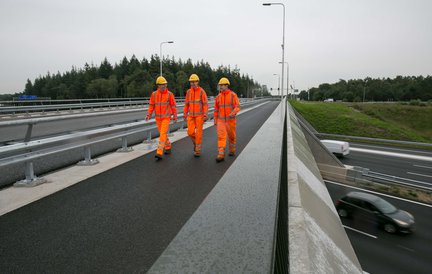
Erwin: “In terms of financing we have negotiated agreements with the bank. They apply a certain financing curve. You can spend your money sooner, but then you have to pre-finance this yourself. You can also spend it later, but then you get your money later as well. If our estimates are off and we have to move up our maintenance, this costs Heijmans money. In this respect, you therefore want to invest as late as possible. The banks in turn want to achieve a certain yield. Everything must be documented. If we fail to achieve a certain level of quality, this also represents a risk to them that they will not achieve their expected yield.”
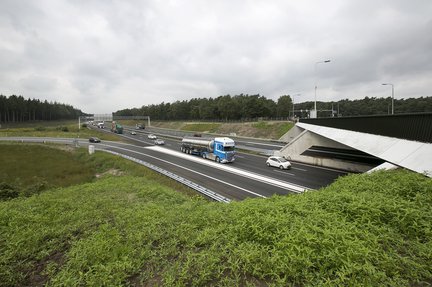
Ideal Maintenance Period
Erwin: “The most significant maintenance generally occurs between 8 and 10 years. If you can as much as possible stretch this to years 10 or later, this means that you will deliver a beautiful area after 15 years. But if the contract term is 20 years, that makes it a lot more difficult. In that case, you may have to undertake major maintenance just before delivery. In this project, the contract term is synchronized with the connection with the A12 Poort van Bunnik, which will also be delivered in 16 years.
The A1/A27 that Heijmans recently contracted has a term of 25 years. This is really very long. Some people that will be working on this project have not yet been born and there are people who are working on it now that will not see the end of it. Weird to imagine this. If you were to go back in time 16 years and you realize the developments that have taken place over this period of time and how fast they all occurred, then you realize that it is almost impossible to make any predictions. This is why it is so important to properly assess the risks. It is difficult to come up with an ideal contract term. However, because Rijkswaterstaat is experimenting with different contract terms, we may be in a position to say something meaningful about this in a few years’ time.”
Contact us

